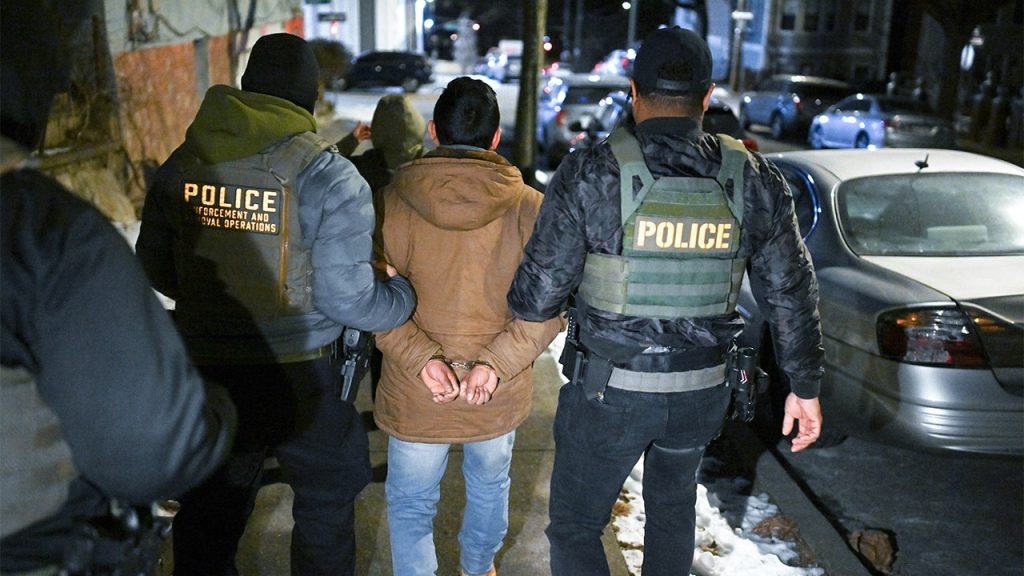In a significant announcement, Todd Lyons, the acting director of U.S. Immigration and Customs Enforcement (ICE), has stated that the agency will intensify its enforcement efforts in sanctuary cities that refuse to cooperate with federal immigration authorities. Emphasizing the importance of public safety, Lyons conveyed a robust commitment to pursue criminal illegal immigrants, irrespective of local sanctuary policies. This development aligns with the Trump administration’s ongoing focus on immigration enforcement and deportations.
| Article Subheadings |
|---|
| 1) Intensified Raids in Sanctuary Cities |
| 2) ICE’s Commitment to Public Safety |
| 3) Collaboration with State Officials |
| 4) Funding and Resources for ICE Operations |
| 5) Public Reaction and Policy Implications |
Intensified Raids in Sanctuary Cities
The rising tensions between ICE and sanctuary cities have reached a critical point, as Todd Lyons declared that raids in these jurisdictions will be significantly increased. Sanctuary cities are defined as municipalities that limit their cooperation with federal immigration enforcement to protect undocumented immigrants from deportation. Lyons emphasized that the agency will not hesitate to exert pressure on these localities if they continue to shield criminals, stating, “If you don’t want to work with us, we’re going to handle the problem.” This statement indicates a potential escalation in immigration enforcement efforts that could affect various communities across the country.
ICE’s Commitment to Public Safety
Lyons underscored the agency’s core mission: protecting public safety by targeting dangerous illegal immigrants. He noted that ICE has already made significant strides in removing individuals involved in violent crimes, such as gang affiliations, sexual offenses, and drug trafficking. “In the first 100 days of the Trump administration, ICE has arrested more than 6,000 illegal immigrants,” Lyons reported. He defended the agency’s operations by emphasizing the necessity of removing individuals who pose threats to communities, positioning ICE as a protector of public safety.
Collaboration with State Officials
Interestingly, not all local leaders oppose the federal agency’s initiatives. Gavin Newsom, the Governor of California, recently announced a willingness to collaborate with ICE despite the state’s sanctuary policies. Typically, California’s approach involves limited cooperation with immigration authorities; however, the governor’s remarks signal a shift toward a more collaborative stance amidst growing public safety concerns around specific cases. Lyons commended Newsom’s approach, particularly regarding a case involving an illegal immigrant convicted of manslaughter due for imminent release. “When people see exactly the individual that ICE is dealing with, how could you not work with ICE in a case like that?” he argued.
Funding and Resources for ICE Operations
As discussions around immigration policy intensify, Lyons highlighted the importance of funding for the agency. The potential approval of additional resources to support 10,000 new agents is seen as a pivotal opportunity to expand ICE’s operational capabilities. “Additional money would be a game changer,” Lyons stated, highlighting past operations that saw criminal aliens released even as ICE was conducting targeted enforcement. This reflects ongoing frustrations with the local and state jurisdictions’ handling of immigration issues, as those released are often from sanctuary jurisdictions that refuse to honor detainer requests.
Public Reaction and Policy Implications
The implications of ICE’s intensified raids are likely to be met with mixed reactions from the public. While some will applaud the aggressive approach toward immigration enforcement, others may raise concerns regarding civil rights and community safety. The debates around sanctuary policies are complex, fueling further discussions on the roles both federal and local governments must play in managing immigration. Overall, how these policies unfold will significantly influence local communities, public sentiment, and even the national conversation on immigration reform.
| No. | Key Points |
|---|---|
| 1 | ICE will increase raids in sanctuary cities refusing cooperation. |
| 2 | Lyons emphasizes ICE’s role in public safety by targeting dangerous individuals. |
| 3 | Collaboration with some state officials like California’s governor is emerging. |
| 4 | Potential funding for additional ICE agents is being considered. |
| 5 | Public reactions to intensified raids are expected to vary significantly. |
Summary
The stance taken by ICE under the leadership of Todd Lyons indicates a definitive pivot toward aggressive enforcement in sanctuary cities. This approach, focusing on public safety, could have lasting implications for the relationship between federal and local authorities. As discussions of potential funding and resources continue, the national conversation around immigration enforcement remains critical, drawing in various stakeholders and the public to engage in finding balanced solutions to complex issues.
Frequently Asked Questions
Question: What are sanctuary cities?
Sanctuary cities are municipalities that adopt policies to resist cooperation with federal immigration enforcement, often to protect undocumented immigrants from deportation.
Question: How does ICE enforce immigration laws?
ICE enforces immigration laws by conducting raids, arrests, and detentions of individuals suspected of being in the country illegally, often focusing on individuals involved in criminal activities.
Question: Why is state cooperation with ICE important?
State cooperation with ICE is critical for effective immigration enforcement, especially in cases where individuals pose significant public safety threats, facilitating smoother operations and may prevent the release of dangerous offenders back into communities.


